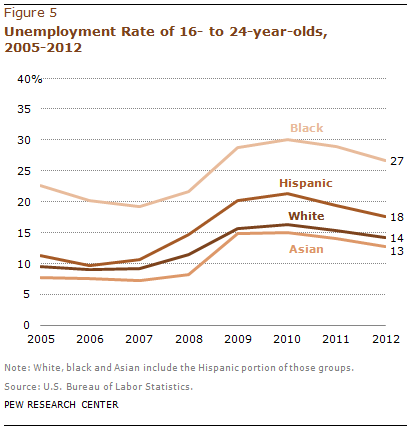 In October 2012 66% of all recent high school completers were enrolled in college. Among Hispanics who had recently graduated high school, 69% were enrolled.
In October 2012 66% of all recent high school completers were enrolled in college. Among Hispanics who had recently graduated high school, 69% were enrolled.
As recently as the class of 2000, only 49% of Hispanic high school graduates immediately enrolled in college the following fall. Since then general college-going has increased among all of the nation’s high school graduates, but it has risen the most—by 20 percentage points—among Hispanic high school graduates.4
In the class of 2012 Hispanic high school graduates (69%) were more likely to be enrolled in college in October 2012 than either whites (67%) or blacks (63%). In 2012 Asian recent high school completers were the most likely of the major racial and ethnic groups to be enrolled in college in October (84%).
 Data on traditional college enrollment from October 2011 indicate that Hispanics and whites tend to attend different kinds of colleges and have different rates of degree completion.
Data on traditional college enrollment from October 2011 indicate that Hispanics and whites tend to attend different kinds of colleges and have different rates of degree completion.
In October 2011, some 72% of white 18- to 24-year-old college students were enrolled at four-year colleges or universities compared with 56% of Hispanic college students.
Also, among college students attending a four-year college or university, whites are more likely than their Hispanic counterparts to be at an academically selective institution (Bozick and Lauff, 2007).
 When young Latinos go to college they are less likely than their white counterparts to be enrolled full time. In October 2011 only 78% of Hispanic 18- to 24-year-old college students were enrolled full time. By comparison, 85% of similar whites were enrolled full time.
When young Latinos go to college they are less likely than their white counterparts to be enrolled full time. In October 2011 only 78% of Hispanic 18- to 24-year-old college students were enrolled full time. By comparison, 85% of similar whites were enrolled full time.
Partly reflecting these differences in college-going and other factors, young Latinos are less likely than their white counterparts to complete a bachelor’s degree. According to Census Bureau data, in March 2012 22% of white 22- to 24-year-olds had attained at least a bachelor’s degree. Young Latinos were half as likely to have finished a four-year college degree (11%).
Finally, the finding that the immediate college entry rate for Latinos in 2012 (69%) exceeds that of whites (67%) does not imply that young Latinos are more likely to attend college than young whites. Recent high school completers are only a subset of youth. Some youth recently dropped out of high school, others dropped out in earlier years, and some were never enrolled in U.S. schools. The immediate college entry rate only refers to youth recently graduating high school. Furthermore, it is possible that a youth could delay attending college after being out of high school for some time.
 It is beyond the scope of this report to explain why Hispanic college-going among recent high school graduates has steeply increased. Since 2008 the Hispanic immediate college entry rate has increased from 62% to 69%. The white immediate entry rate declined from 71% in 2008 to 67% in 2012.
It is beyond the scope of this report to explain why Hispanic college-going among recent high school graduates has steeply increased. Since 2008 the Hispanic immediate college entry rate has increased from 62% to 69%. The white immediate entry rate declined from 71% in 2008 to 67% in 2012.
One possible explanation for the divergence in college-going between Hispanics and whites since the Great Recession is the different labor market circumstances these groups have faced. Hispanic and white youth tend to live in different parts of the country, and, overall, the employment opportunities since the onset of the recession deteriorated more for Hispanic youth than for white youth.
 Since 2007 the Hispanic 16- to 24-year-old unemployment rate has increased by seven percentage points, compared with a five percentage point increase among white 16- to 24-year-olds. With fewer opportunities to find jobs, it is possible that more young Latinos decided to extend their education. However, the Pew Research Center has not rigorously analyzed the relationship between the labor market and college-going; thus we simply note the correlation without drawing a causal connection.
Since 2007 the Hispanic 16- to 24-year-old unemployment rate has increased by seven percentage points, compared with a five percentage point increase among white 16- to 24-year-olds. With fewer opportunities to find jobs, it is possible that more young Latinos decided to extend their education. However, the Pew Research Center has not rigorously analyzed the relationship between the labor market and college-going; thus we simply note the correlation without drawing a causal connection.


